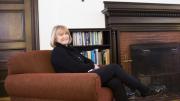The great concert organistand sometime radio-broadcast starE. Power Biggs brought fame to himself and limelight to Harvard on an organ that he came to own, designed by G. Donald Harrison and resident in what was then the Germanic Museum (later the Busch-Reisinger Museum, now the Gunzburg Center for European Studies). Craig R. Whitney '65 describes the first of many Biggs performances there in All the Stops: The Glorious Pipe Organ and Its American Masters (Public Affairs, $30). (Biggs later replaced the organ with an improved one by Dirk A. Flentrop, which in time he donated to Harvard. Biggs's successors concertize on it often.)
 |
| Biggs, illuminated by a shaft of light, in a poster by Crawford Livingston |
| The American Guild of Organists Organ Library |
Into the museum balcony the organ went in 1937, the pipes of the 25 stops laid out on three windchests, standing bravely in the open without any decorative casework or any attempt at visual design; a showroom for the new American Classic idea. Harrison was not interested in becoming a builder of neobaroque organs, but, he wrote at the time, "The organ has been romanticized, and its fundamental character has been lost." Harrison wanted to get back to the basics: "Classical organ music, particularly that of J.S. Bach, is polyphonic in form and, therefore, great clarity of tone is essential for the proper rendition of these works in order that the interweaving of the various voices or parts may be heard distinctly by the listener. It is not surprising, therefore, to find that clarity and transparency of tone are the most striking characteristics of the organs of the seventeenth and eighteenth centuries. An attempt has been made to recapture these desirable qualities in the Germanic Museum instrument."
The opening recitals by Biggs on April 13 and 18, 1937, were a major musical event. He played identical programs of music by Handel, Louis-Claude Daquin, who was the court organist at Versailles during the reign of Louis XIV, and Bachthe Fantasy and Fugue in G minor. The impression the instrument created was as dramatic as he could have hoped for. "The beautiful tone of the instrument, lighter in texture, sweeter and more mellow than that of the average instrument built according to modern specifications, was yet capable of grandeur," the Christian Science Monitor found, and Moses Smith, the Boston Evening Transcript critic, ...wrote,...."The polyphonic development was far clearer than it is on the typical contemporary instrument." That, Smith observed, was "a tonal anomaly, a bad imitation of an orchestra."... [T]he general press covered the new organ, and Biggs as its leading exponent, as major cultural news. The Boston Herald even wrote an editorial about it, entitled "The New Classical Organ: A Victory for Bach."
Biggs had found his vehicle, an instrument that in his hands, as [organ expert Emerson] Richards wrote [in the American Organist], "revealed to us a music so new, so arresting, and so alive that we cannot believe it is the same old stodgy, uninteresting and decadent set of notes that have been running through the fingers of our organists since the middle of the last century....If we were writing this for Variety we would say that Mr. Biggs 'laid them in the aisles.'"





